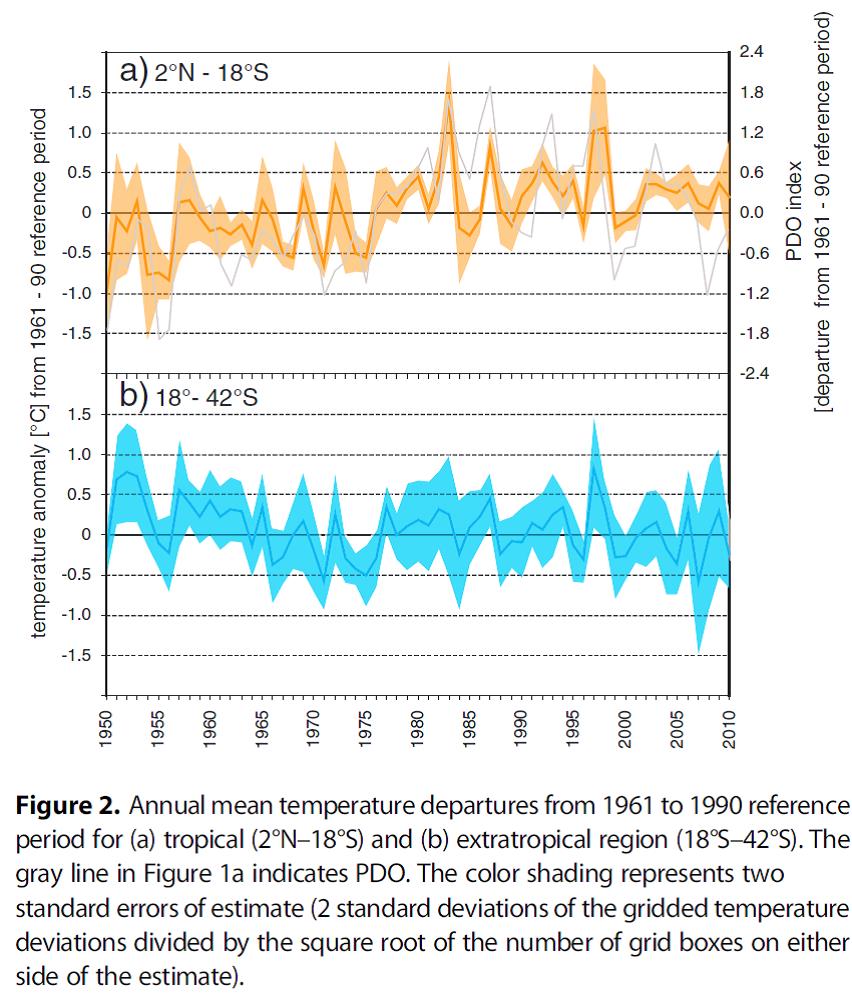No warming in Andes Mountains since 1950
By Dr.Sebastian Lüning and Prof. Fritz Vahrenholt
(German translated by P Gosselin)
The unpopular hiatus just keeps coming up. But climate activists are remaining defiant and continue to deny it exists. They continue to claim that temperature is rising. Yet, the scientific community has long since accepted the pause and has written a series of papers on the phenomenon. For example Vuille et al. 2015:
Impact of the global warming hiatus on Andean temperature
The recent hiatus in global warming is likely to be reflected in Andean temperature, given its close dependence on tropical Pacific sea surface temperature (SST). While recent work in the subtropical Andes has indeed documented a cooling along coastal areas, trends in the tropical Andes show continued warming. Here we analyze spatiotemporal temperature variability along the western side of the Andes with a dense station network updated to 2010 and investigate its linkages to tropical Pacific modes of variability. Results indicate that the warming in tropical latitudes has come to a halt and that the subtropical regions continue to experience cooling. Trends, however, are highly dependent on elevation. While coastal regions experience cooling, higher elevations continue to warm. The coastal cooling is consistent with the observed Pacific Decadal Oscillation (PDO) fingerprint and can be accurately simulated using a simple PDO-analog model. Much of the PDO imprint is modulated and transmitted through adjustments in coastal SST off western South America. At inland and higher-elevation locations, however, temperature trends start to diverge from this PDO-analog model in the late 1980s and have by now emerged above the 1σ model spread. Future warming at higher elevation is likely and will contribute to further vertical stratification of atmospheric temperature trends. In coastal locations, future warming or cooling will depend on the potential future intensification of the South Pacific anticyclone but also on continued temperature dependence on the state of the PDO.
65 years without warming
Take a look at Figure 2b of this paper. The blue curve is the temperature development in the extra-tropical Andes. Clear to see: No warming since 1950! That’s a full 65 years without warming. The scientists found a strong influence by the 60-year Pacific Decadal Oscillation (PDO).

Chart source: Vuille et al. 2015





OT but this massive solar fail affecting two continents is too good to miss….
http://www.channelnewsasia.com/news/business/abengoa-unit-files-for-us/2546608.html
Abengoa website
http://www.abengoa.com/web/en/index3.html
“We ensure that our products, services and processes are sustainable”
Their debt certainly seems to be.
P.S.
(also from their website)
Nothing says “ORGANIC SUSTAINABLE” more than a Gemisch of high-tech climate bling.
The article makes reference to the PDO. Readers might like to know more.
Below is a link to an ‘abstract’ wherein there are links to much more.
Paper title: “A Pacific interdecadal climate oscillation with impacts on salmon production” [1997]
http://www.atmos.washington.edu/~mantua/abst.PDO.html
“Evidence gleaned from the instrumental record of climate data identifies a robust, recurring pattern of ocean-atmosphere climate variability … “
The higher you go the bigger the global warming trend should be as you approach the tropospheric hotspot predicted by warmunist theory (but never observed by weather balloons or satellites).
Something’s wrong with the theory.
No, Dirk, the theory predicted that the hot spot would arrive but not precisely when and certainly not during a pause. This follows from the first axiom of drama science: an actor should not arrive at the scene when everybody is drinking coffee. The pause is over when all heat, accumulated in the oceans, begins to escape, rises up in the troposphere, and makes hot spot. That cannot happen now because we are still in the pause.
Well, there should never have been a pause in the first place…
“Something’s wrong with the theory.”
I’ll say! Have those aging hippies who concocted that nonsense forgotten that, “The higher you go, the cooler it gets, …man.”
O/T Interesting data from real life drive test of six electric cars.
From the respectable Heise Verlag (publishers of c’t).
http://www.heise.de/autos/artikel/Elektroauto-Vergleichstest-3073803.html?artikelseite=3
I used to estimate the consumption of a real electric commuter care as 19kWh/100km as I got this number from a test of the Chevy Volt hybrid in electric mode.
This number is still a good estimate even for pure EV’s, as the Heise article shows.